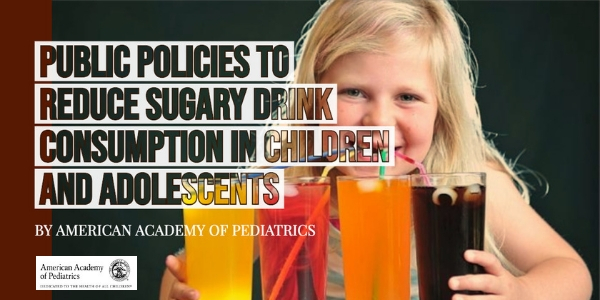
AAP, AHA joint policy to Reduce Sugary Drink Consumption in Children and Adolescents
 The American Academy of Pediatrics(AAP) and the American Heart Association(AHA) have recently released a suite of public health measures — including excise taxes, limits on marketing to children, and financial incentives for purchasing healthier beverages — designed to reduce kids’ consumption of sugary drinks.
The American Academy of Pediatrics(AAP) and the American Heart Association(AHA) have recently released a suite of public health measures — including excise taxes, limits on marketing to children, and financial incentives for purchasing healthier beverages — designed to reduce kids’ consumption of sugary drinks.
The policy statement reads that the excess consumption of added sugars, especially from sugary drinks, contributes to the high prevalence of childhood and adolescent obesity, especially among children and adolescents who are socioeconomically vulnerable. It also increases the risk of dental decay, cardiovascular diseases, hypertension, dyslipidemia, insulin resistance, type 2 diabetes mellitus, fatty liver disease, and all-cause mortality. The 2015–2020 Dietary Guidelines for Americans recommend that added sugars contribute less than 10% of total calories consumed, yet US children and adolescents report consuming 17% of their calories from added sugars, nearly half of which are from sugary drinks. Decreasing sugary drink consumption is of particular importance because sugary drinks are the leading source of added sugars in the US diet, provide little to no nutritional value, are high in energy density, and do little to increase feelings of satiety. To protect child and adolescent health, broad implementation of policy strategies to reduce sugary drink consumption in children and adolescents is urgently needed.
On average, children and teens today consume more than 30 gallons of sugary drinks every year which is enough to fill a bathtub.
The policy statement “Public Policies to Reduce Sugary Drink Consumption in Children and Adolescents,” includes the following recommendations.
1. Local, state, and/or national policies intended to reduce consumption of added sugars should include the consideration of approaches that increase the price of sugary drinks, such as an excise tax. Such taxes should be accompanied by education of all stakeholders on the rationale and benefits of the tax before implementation. Tax revenues should be allocated, at least in part, to reducing health and socioeconomic disparities.
2. The federal and state governments should support efforts to decrease sugary drink marketing to children and adolescents.
3. Federal nutrition assistance programs should aim to ensure access to healthful food and beverages and discourage consumption of sugary drinks.
4. Children, adolescents, and their families should have ready access to credible nutrition information, including on nutrition labels, restaurant menus, and advertisements.
5. Policies that make healthy beverages the default should be widely adopted and followed.
6. Hospitals should serve as a model and implement policies to limit or disincentivize the purchase of sugary drinks.
Conclusions of the policy statement:
Consumption of added sugars, particularly those in sugary drinks, pose a significant health risk to children and adolescents. Paediatricians are encouraged to routinely counsel children and families to decrease sugary drink consumption and increase water consumption. Paediatricians can also advocate for policy change through school boards, school health councils, hospital and medical group boards and committees, outreach to elected representatives, and public comment opportunities. Policy targets, such as those discussed in this report and summarized below, are needed to reduce sugary drink consumption in children and adolescents and subsequently improve child health.
Source: https://pediatrics.aappublications.org/content/143/4/e20190282